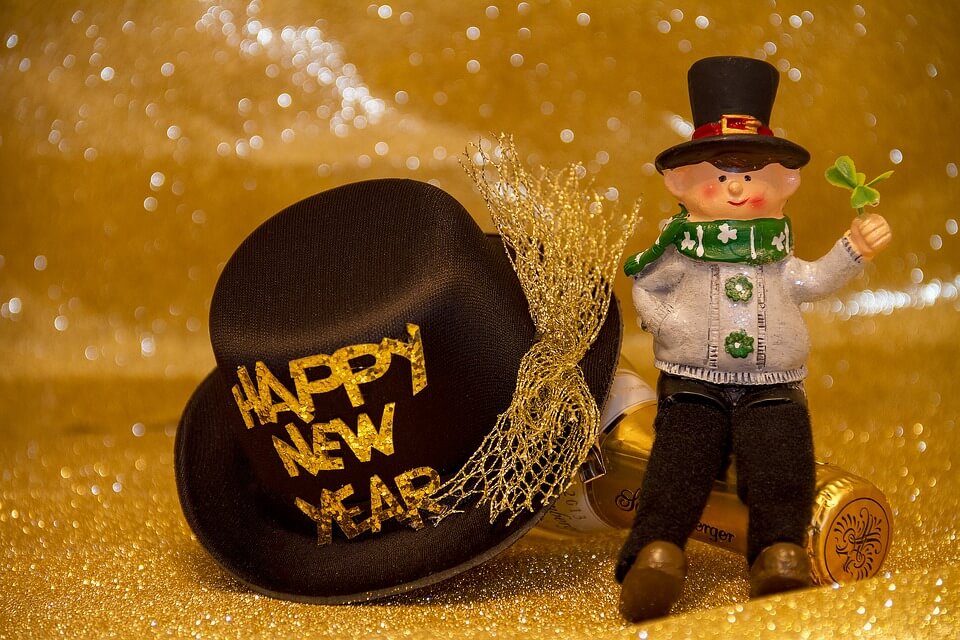In some societies, both past and present, the beginning of the year falls on different dates. In Italy, for example, according to the Roman calendar, the new year began on March 46st, until in XNUMX BC Julius Caesar gave life to the new Julian calendar, moving the watershed to January XNUMXst.
There are many New Year's rites that, through the centuries, have come down to us and that we dust off every year

New Year = XNUMXst January, even if it is not so obvious
The same, up to the Middle Ages, for the New Year other “alternative” dates also remained suspended, for example 1 or 25 March or even 25 December. In 1582 Pope Gregory XIII launched his new calendar and the date of January XNUMXst as the beginning of the year finally became common.
The name January, from the Latin Januarius, it is instead a tribute to the god Janus, called Brifronte because he has two faces, once in the past and the other looking to the future.
The allusion to the symbolic passage from the old to the new year is clear, a change that all populations have always wanted to celebrate with gestures, behaviors and propitiatory rites, religious or profane, in any case aimed at washing away past evil, removing negative influences and curry favor with the time to come. Superstitious rituals with which we try to ward off bad luck, convinced or more skeptical, however faithful to the saying: it's not true but I believe it.
What are the most common New Year's rites? Here is our TOP 11
Botti & Co
In almost all the cultures of the world, the important moments that mark a change, religious or secular, solemn, sad or festive, have always been underlined with noise, whether they are blanks, bells, drum rolls, gongs, firecrackers, beating of hands. The meaning? Don't get distracted, be careful: you are living a very special moment.
Now, however, more and more cities are banning barrels. Security must always prevail over superstition.
Lucky food

Eat the lentils and eating lots of them, is the categorical input of the New Year's table. The shape of these legumes in fact recalls that of coins, therefore symbolically herald the arrival of money.
How to pomegranate and grapes, they are grains and have always been considered the harbingers of a rebirth, including an economic one.
The chili pepper in many Italian regions is instead used for garlands or hung on doors as a good luck rite. After all, everything that is red, since ancient times, has been considered a good luck charm because the color par excellence linked to the Winter Solstice, December 21st: vermilion like the sun, blood, heat, life itself.
Good luck meetings
The versions have now multiplied. If you meet a man at the beginning of the morning, as a first person, it will be a year, yes, if he is female, the opposite will happen! Or, for girls: if you see a man first, you'll get married soon. If you see a woman, you'll have to wait.
Meeting an old man or a hunchback is a good omen, if you come across a child or a priest, not!
Fire red underwear

The color of passion, the red for underpants, outfits, garters. A custom that symbolically connects to fertility and the birth of a new life.
Magical bonfire
The last of the year has always been celebrated with fire, therefore with heat and life. The ancients in this period of the Winter Solstice, the darkest of the year, encouraged the sun by celebrating it as an invictus, invincible: courage, you seem defeated by the darkness but we know that you will be reborn again, returning to shine, above. In the meantime, to help you, let's turn on some light.
Brooms drives away evils
They are small miniature sorghum brooms that in some regions are still attached to gifts or to the doors of the house. The symbolic meaning? Simple, wipe out all evils.
Greedy gifts also called strennas
With the boyfriend or with the best friend, it is customary to exchange them also for the new year. Our Roman ancestors exchanged gifts such as dates, honey and dried figs so that the coming year would be sweet, accompanied by laurel twigs called strenae, as a wish for happiness and luck.
If you do it on New Year's Eve .. then you will do it all year round
Believe it or not, it's about work or private life, if we don't like something we avoid doing it on January XNUMXst. At any rate. Why go and look for them?
Bingo!
In ancient times the "change of year" was the only period in which, both nobles and commoners, were allowed the gamble.
The bingo, the Merchant at the fair, the Monopoli and other traditional pastimes of the last year refer to that custom.
Get rid of the old things
Let's not throw them out the window, of course. Here the game is discovered. THE shards and the old they are a ballast that belongs to the past and, therefore, no longer needed: they must give way to the new and the most beautiful in the coming months.
Mistletoe kissed

It is not a random choice, kiss under the mistletoe. In Celtic civilization it was a sacred plant that indicated the renewal of life and was thought to bring good luck: it could only be cut once a year, in the New Year period, and only by the druids, the supreme leaders, with a golden sickle.
And even today on New Year's Eve mistletoe is put on the window, but also candles or red flowers to propitiate good luck in love.






